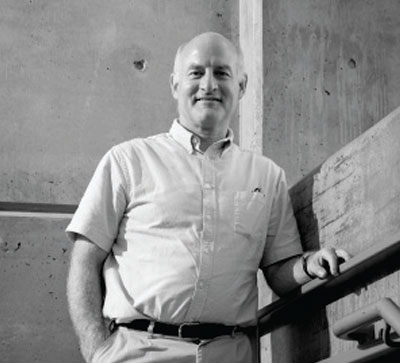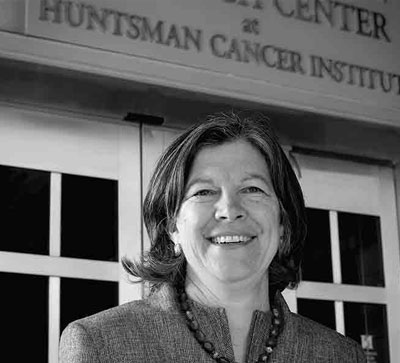THINKING BEYOND THE CAMPUS

Wes Sundquist, Ph.D., professor and co-chair of biochemistry, pushes the ideas of sharing and team science far beyond the institutional level. For the past seven years, he’s been the PI on two five-year NIH P50 grants totaling $41 million to create a national center of researchers studying the structural biology of HIV.
The center, known as CHEETAH, has 16 scientific cores run by 12 different investigators at seven institutions including the University of Utah (which houses seven of the cores), Scripps Research Institute, California Institute of Technology, University of Virginia, Northwestern University, Stanford University and the University of Chicago.
As the director of the center, part of Sundquist’s job is to provide members and external collaborators easy access to and expert guidance on state-of-the-art technologies that are revolutionizing the way scientists are able to study cellular structures. “Advances in electron microscopy have now made it possible, in favorable cases, to determine the position of every single atom in very complex biological assemblies such as viruses,” says Sundquist. “This means we now have the tools necessary to figure out precisely how the complicated machines of the cell really work.”
Beyond sharing high-tech resources, Sundquist brings together some of the country’s best scientific minds to try to solve new pieces of the HIV puzzle. He’s hopeful that research coming out of the center will lead to new therapeutics and ultimately effective ways to prevent HIV transmission. “We couldn’t do this research as a single lab,” he says. While he admits that it’s much easier to collaborate with colleagues across the hall, Sundquist believes that creating well connected, global networks of researchers, brimming with diversity, is the key to next-generation scientific breakthroughs.
Yet even within this ideal team structure, Sundquist encourages researchers in his lab to explore their own ideas—not just the national team’s common goals. “Never underestimate the impact that single individuals or small teams with great ideas and dedication can still have,” he says. “We don’t just want to be part of a pipeline. That’s not science.”
Q&A with Wes Sundquist
Wes Sundquist, Ph.D., professor and co-chair of biochemistry, is the principal investigator on two five-year NIH P50 grants totaling $41 million, has created a national center of researchers studying the structural biology of HIV.
What do you think are the ways HIV research could benefit humanity in the future?
We now understand that cells have very effective ways of fighting back against viral infections (including HIV), called innate immune responses. The extent of these defenses wasn't clear, even just a few years ago because it often goes unnoticed when our defenses are able to fight off a viral infection and because viruses that are successful typically have effective countermeasures against our innate defenses. Now that we know that we know how extensive our innate immune responses can be, we realize that it may be possible to strengthen them so that they can defend us even better against pathogenic viruses. To do that, however, we really need to understand how each of our innate immune responses actually works, and that's a fundamental goal of one of the projects in our lab (and the work of others in our field). Another project in our lab focuses on understanding how viruses like HIV escape cells so that they can spread infections. The cellular pathway that we first showed is used by HIV to escape cells has subsequently been shown to be used by dozens of other viruses of all different types. Inhibitors of this pathway could therefore, in principle, provide broad protection against many different types of viruses. The catch is that the pathway also performs very important functions in the cell, including during cell division, so we need to understand the pathway in detail in order to learn whether there are parts of the pathway that are essential for viruses, but not essential for cells. Finally, I would emphasize the importance of doing high quality research on fundamental problems, even if we don't know exactly where it will lead. Gaining significant new insights into fundamental natural processes inevitably opens up new possibilities for beneficial applications and new therapeutics, even if we can't predict what they will be in advance.
What are two scientific discoveries that excite you right now?
The first is the discovery that the cellular pathway that have studied because it is used by viruses to escape cells turns out also to be used by the cell to complete the final step in cell division, I.e., the separation of the two nascent daughter cells. I think this discovery itself is very exciting, but I find it even more remarkable that although scientists have studied cell division for more than a century, we still hadn't identified the machinery that separates the two daughter cells. This tells me that there are still very fundamental discoveries to be made in the biosciences. More generally, I am excited by the power of advancing technologies, particularly in the area of imaging, that make it possible to study cellular structures and functions in far greater detail than has ever been possible before. To pick one significant example, advances in electron microscopy have now made it possible, in favorable cases, to determine the position of every single atom in very complex biological assemblies such as viruses (the agents that infect us) or ribosomes (the machines that make proteins). This means that we now have the tools necessary to figure out precisely how the complicated machines of the cell really work.
What are your feelings about the future?
I, like many scientists I know, have very mixed feelings about the future. It is tremendously exciting that we are finally getting tools necessary to figure out many of nature's most interesting secrets and that we are learning how to design new therapeutics more rationally (rather than discovering them simply by chance). At the same time it is frustrating that biomedical research funding is getting more problematic just at the time that these advances seem poised to bear greater fruit than ever before.
How has science changed?
I would say that science has become much more collaborative and team oriented as the tools have become more sophisticated and the problems being tackled have become bigger. It is now virtually impossible for any single person or lab to do everything well. This transformation has largely taken place in physics, where large multidisciplinary team science already prevails, and it is clearly also the trend in biomedical research. That said, we shouldn't underestimate the impact that single individuals or small teams with great ideas and dedication can still have.

